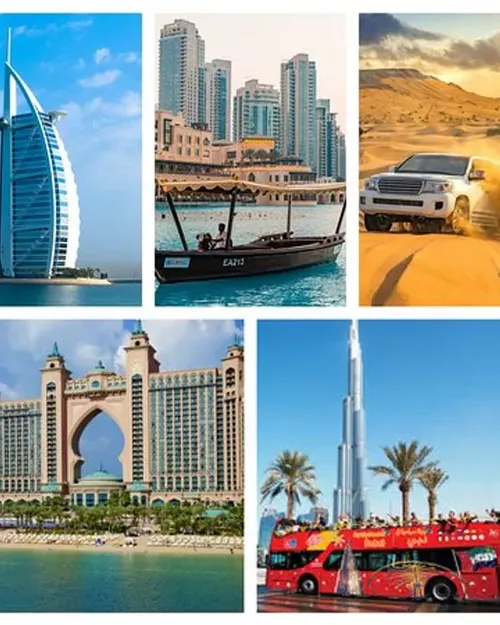United Arab Emirates is popular for
United Arab Emirates in next 3 month
Weather in United Arab Emirates
December in the United Arab Emirates is cool with clear skies and good air quality.
Usual trip duration
A 3-4 day trip to the United Arab Emirates allows you to explore the iconic city of Dubai, visit the stunning Sheikh Zayed Grand Mosque in Abu Dhabi, and experience the desert safari and Bedouin culture. This duration provides a good balance of city sightseeing and cultural experiences.
Expensive
Ideas To Plan Your Trip
Places To Visit
Places To Eat
Frequently Asked Questions about the United Arab Emirates (UAE)
The best time to visit the United Arab Emirates is during the cooler months, from November to April. During this period, the weather is pleasant and more conducive to outdoor activities and sightseeing. The temperatures are generally in the range of 20°C to 30°C (68°F to 86°F), making it ideal for exploring the cities, deserts, and beaches. This is also the peak tourist season, so expect larger crowds and higher prices for accommodations and activities.
Conversely, the summer months, from May to September, are extremely hot and humid, with temperatures often soaring above 40°C (104°F). While many indoor attractions are air-conditioned, outdoor activities can be challenging and uncomfortable. However, some travelers may find deals on hotels and fewer crowds during this off-season, especially in cities like Dubai and Abu Dhabi which are well-equipped to handle extreme heat.
For those interested in specific events, consider planning your trip around events like the Dubai Shopping Festival (usually in January and February) or the Abu Dhabi Grand Prix (usually in November or December). Ramadan, the Islamic holy month, also affects travel, with adjusted hours for shops and restaurants, but can offer a unique cultural experience.
The United Arab Emirates boasts a diverse range of attractions, from futuristic cityscapes to historical sites and natural wonders. Here's a list of some must-visit places:
| Attraction | Location | Highlights |
|---|---|---|
| Burj Khalifa | Dubai | The world's tallest building, offering breathtaking panoramic views of Dubai. |
| Sheikh Zayed Grand Mosque | Abu Dhabi | A stunning architectural masterpiece with intricate designs and a serene atmosphere. |
| The Dubai Mall | Dubai | One of the largest shopping malls in the world, offering a wide range of retail outlets, entertainment options, and dining experiences. |
| Louvre Abu Dhabi | Abu Dhabi | A universal museum showcasing art and artifacts from around the world, with a focus on bridging the gap between different cultures. |
| Dubai Desert Conservation Reserve | Dubai | A protected area offering various desert activities such as dune bashing, camel riding, and traditional Bedouin experiences. |
| Qasr Al Watan | Abu Dhabi | The Presidential Palace of the UAE, offering insights into the governance and culture of the nation. |
| Hatta | Dubai (Mountain Area) | A mountainous exclave of Dubai, offering outdoor activities like hiking, kayaking, and mountain biking. |
The United Arab Emirates is a major international travel hub with excellent connectivity to the rest of the world. Here are the primary ways to reach the UAE:
| Mode of Transport | Details |
|---|---|
| By Air | The UAE has several international airports, with Dubai International Airport (DXB) and Abu Dhabi International Airport (AUH) being the largest and busiest. These airports offer flights to and from destinations all over the world. Airlines like Emirates and Etihad Airways are the national carriers and offer extensive international routes. Sharjah International Airport (SHJ) also serves many destinations, particularly budget airlines. |
| By Sea | While not the most common way to arrive, the UAE has several major ports that accommodate cruise ships and cargo vessels. Cruise lines often include Dubai or Abu Dhabi as a stop on their itineraries, offering a unique way to experience the country. |
| By Land | The UAE shares land borders with Saudi Arabia and Oman. It is possible to enter the UAE by road, either by bus or private vehicle. However, this option is more common for residents of neighboring countries. Crossing borders requires proper documentation and visa arrangements. |
Regardless of your chosen mode of transport, ensure you have the necessary visa and travel documents before embarking on your journey to the UAE. Check the latest travel advisories and entry requirements from your country and the UAE government.
The UAE offers a plethora of activities to suit every interest, from adventurous desert escapades to luxurious city experiences. Here's a glimpse of what you can enjoy:
- Desert Adventures: Experience the thrill of dune bashing, camel riding, sandboarding, and quad biking in the vast Arabian Desert. Enjoy traditional Bedouin hospitality with desert safaris and overnight camping experiences.
- Water Sports: Take advantage of the UAE's stunning coastline and engage in water sports such as jet skiing, parasailing, windsurfing, and scuba diving. Explore the underwater world with snorkeling and diving tours.
- Cultural Experiences: Immerse yourself in the rich Emirati culture by visiting historical sites, museums, and traditional markets. Participate in cultural tours, attend traditional dance performances, and savor authentic Emirati cuisine.
- Shopping: Indulge in retail therapy at the UAE's world-class shopping malls and traditional souks. Discover luxury brands, local handicrafts, and unique souvenirs. Don't miss the Dubai Shopping Festival for incredible deals and entertainment.
- Theme Parks and Entertainment: Have a fun-filled day at the UAE's numerous theme parks, water parks, and entertainment centers. Experience thrilling rides, live shows, and interactive attractions.
- Luxury Experiences: Pamper yourself with luxurious experiences such as spa treatments, fine dining, and stays at opulent hotels. Enjoy exclusive access to private beaches, rooftop bars, and VIP events.
The UAE's strategic location makes it a great base for exploring other countries in the region. Here are some popular nearby destinations to consider:
| Destination | Distance from Dubai (approx.) | Highlights |
|---|---|---|
| Oman | ~ 500 km (to Muscat) | Stunning landscapes, including mountains, deserts, and coastline. Visit Muscat, Nizwa, and Salalah for cultural and historical experiences. |
| Bahrain | ~ 500 km | Rich history and culture, with ancient forts, mosques, and museums. Visit Manama, the capital city, for shopping, dining, and entertainment. |
| Qatar | ~ 700 km | Modern architecture, cultural attractions, and luxury experiences. Visit Doha, the capital city, for museums, parks, and shopping malls. |
| Saudi Arabia | Bordering the UAE | Home to holy Islamic sites like Mecca and Medina. Explore historical sites, cultural landmarks, and modern cities like Riyadh and Jeddah. |
Keep in mind visa requirements and travel restrictions may apply, so ensure to check those before planning your trip.
The UAE is a shopper's paradise, offering a diverse range of retail experiences, from luxury boutiques to traditional souks. Here are some of the best shopping spots in the UAE:
| Shopping Destination | City | Highlights |
|---|---|---|
| The Dubai Mall | Dubai | One of the world's largest shopping malls, featuring a vast selection of retail outlets, entertainment options, and dining experiences. |
| Mall of the Emirates | Dubai | Another popular shopping mall, known for its luxury brands, entertainment options, and the iconic Ski Dubai indoor ski resort. |
| Abu Dhabi Mall | Abu Dhabi | A comprehensive shopping destination with a mix of high-street brands, department stores, and dining options. |
| Souk Madinat Jumeirah | Dubai | A traditional Arabian bazaar with a modern twist, offering a variety of handicrafts, souvenirs, and local products. |
| Gold Souk | Dubai | A vibrant marketplace specializing in gold jewelry, precious stones, and traditional Arabian designs. |
The UAE's culinary scene is as diverse as its population, offering a wide range of dining options from traditional Emirati cuisine to international flavors. Here are some recommended restaurants in the UAE:
| Restaurant | City | Cuisine | Highlights |
|---|---|---|---|
| Al Ustad Special Kabab | Dubai | Iranian | A popular spot for delicious and affordable kebabs, known for its walls adorned with photos of satisfied customers. |
| Zuma | Dubai, Abu Dhabi | Japanese | A sophisticated Japanese restaurant offering contemporary dishes in a stylish setting. |
| Pierchic | Dubai | Seafood | An elegant seafood restaurant located on a pier, offering stunning views of the Arabian Gulf. |
| Li Beirut | Abu Dhabi | Lebanese | Offers a refined dining experience, known for its modern take on traditional Lebanese dishes. |
| Logma | Dubai, Abu Dhabi | Emirati | A contemporary eatery that serves modern interpretations of Emirati cuisine, offering a taste of local flavors in a casual setting. |
The official currency of the United Arab Emirates is the Emirati Dirham, often abbreviated as AED. It is also sometimes abbreviated as Dhs or DH. The dirham is pegged to the US dollar at a rate of approximately 3.6725 dirhams per 1 US dollar. This fixed exchange rate provides stability for businesses and tourists alike.
Dirhams are available in both coins and banknotes. Coins come in denominations of 1, 5, 10, 25, and 50 fils, and 1 dirham. Banknotes are available in denominations of 5, 10, 20, 50, 100, 200, 500, and 1000 dirhams.
Credit cards are widely accepted throughout the UAE, especially in major cities and tourist areas. ATMs are also readily available for withdrawing cash. It's a good idea to have some cash on hand for smaller establishments, souks, and tipping.
The official language of the United Arab Emirates is Arabic. It is the language used in government, education, and official documents. Modern Standard Arabic is the formal version used, but the local dialect is also prevalent in everyday conversations.
However, English is widely spoken and understood throughout the UAE, particularly in business, tourism, and hospitality sectors. You'll find that most signs, menus, and informational materials are available in both Arabic and English. In major cities like Dubai and Abu Dhabi, you can easily navigate and communicate using English.
Other languages spoken in the UAE include Hindi, Urdu, Tagalog, and various European languages, reflecting the diverse expatriate population of the country. While knowing some basic Arabic phrases can be appreciated, it's not essential for most visitors.
The United Arab Emirates is a Muslim country with a rich cultural heritage. It's important to be respectful of local customs and traditions, especially during religious holidays like Ramadan. Here are some cultural customs to be aware of:
- Dress Code: While the UAE is relatively liberal compared to other countries in the region, it's advisable to dress modestly, especially in public places and religious sites. Avoid revealing clothing such as shorts, sleeveless tops, and short skirts.
- Public Displays of Affection: Public displays of affection, such as kissing and hugging, are generally frowned upon and may be considered offensive.
- Ramadan: During the holy month of Ramadan, Muslims fast from dawn to dusk. Eating, drinking, and smoking in public during fasting hours are prohibited. Many restaurants and shops have adjusted hours during this period.
- Photography: Be respectful when taking photos, especially of local people. Always ask for permission before photographing individuals, and avoid photographing government buildings or military installations.
- Alcohol Consumption: Alcohol consumption is generally restricted to licensed hotels, restaurants, and bars. It's illegal to drink alcohol in public places or to be intoxicated in public.
- Respect for Religion: Be respectful of Islamic customs and traditions. When visiting mosques, dress modestly and remove your shoes before entering. Avoid making loud noises or engaging in disruptive behavior in religious places.
The United Arab Emirates is generally considered to be a very safe country for tourists. The crime rates are low, and the government places a strong emphasis on maintaining law and order. However, like any travel destination, it's important to take certain precautions to ensure your safety and security.
Petty crime, such as pickpocketing and theft, can occur in crowded areas, so it's important to be vigilant and keep your belongings secure. Avoid leaving valuables unattended, and be cautious when dealing with strangers.
The UAE has strict laws and penalties for drug-related offenses, so it's important to be aware of the regulations and avoid any involvement with illegal substances. Traffic laws are also strictly enforced, so it's important to drive carefully and adhere to speed limits.
The UAE is also prone to extreme weather conditions, such as heatwaves, sandstorms, and flash floods. It's important to stay informed about weather forecasts and take appropriate precautions, such as staying hydrated, wearing sunscreen, and avoiding outdoor activities during extreme heat.
Overall, with a little common sense and awareness, you can have a safe and enjoyable travel experience in the UAE.
The visa requirements for traveling to the UAE depend on your nationality. Many nationalities are eligible for visa-free entry or visa on arrival, while others need to apply for a visa in advance. It's essential to check the specific visa requirements for your country before planning your trip.
Citizens of certain countries, including the GCC (Gulf Cooperation Council) member states (Bahrain, Kuwait, Oman, Qatar, and Saudi Arabia), can enter the UAE visa-free.
Citizens of many other countries, including the United States, Canada, the United Kingdom, and most European countries, are eligible for a visa on arrival, which is valid for a specific period (usually 30 or 90 days).
If you are not eligible for visa-free entry or visa on arrival, you will need to apply for a visa in advance through the UAE embassy or consulate in your country. The type of visa you need will depend on the purpose of your visit, such as tourism, business, or employment.
It's always best to check the latest visa requirements and application procedures on the official website of the UAE government or the website of the UAE embassy or consulate in your country.















































